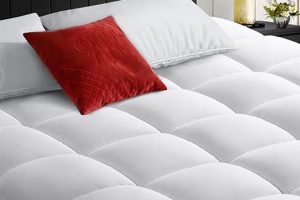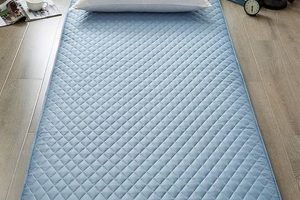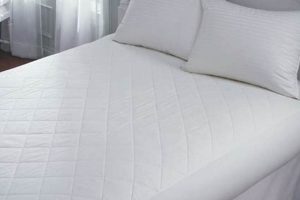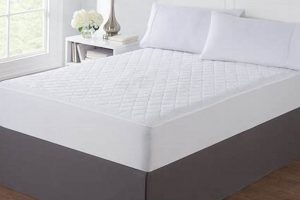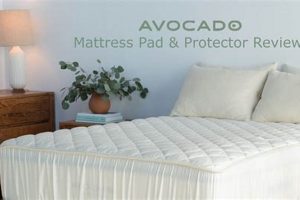Protective layers designed to encase a mattress, incorporating an additional cushioning material, offer a enhanced level of comfort and protection. These items typically feature a filling of fiberfill, down alternative, or memory foam quilted between the outer fabric and an inner lining. For instance, a cover with a thick layer of hypoallergenic fiberfill can create a softer sleep surface while simultaneously safeguarding the mattress from spills and allergens.
The use of such enhanced encasements provides several advantages. They extend the lifespan of the underlying mattress by shielding it from stains, dust mites, and wear. The increased padding enhances the sleeper’s comfort by distributing weight more evenly and reducing pressure points. Historically, simpler mattress protectors were primarily focused on basic hygiene. Modern iterations have evolved to incorporate features designed for both protection and improved sleep quality, reflecting a growing awareness of sleep’s impact on overall well-being.
The following sections will detail the various types of materials used in their construction, methods for proper care and maintenance, and factors to consider when selecting the optimal choice for individual needs and preferences.
Selecting and Maintaining Enhanced Mattress Encasements
The following guidelines offer direction on the proper selection and upkeep of mattress encasements designed with integrated padding for enhanced comfort and protection.
Tip 1: Assess Material Composition: Prioritize hypoallergenic materials, such as bamboo or tightly woven cotton, to minimize allergic reactions. In cases of down alternative fills, confirm the fill is evenly distributed to prevent clumping.
Tip 2: Evaluate Padding Thickness: The thickness of the padding should align with individual comfort preferences. Thicker padding offers greater pressure relief, while thinner padding provides a more responsive surface.
Tip 3: Measure Mattress Dimensions Accurately: Precise measurements of mattress height, width, and length are essential to ensure a secure and proper fit. Ill-fitting encasements can compromise protection and comfort.
Tip 4: Inspect Waterproofing Features: Waterproofing or water-resistant properties are critical for preventing liquid damage. Examine the waterproof membrane for durability and breathability to avoid moisture buildup.
Tip 5: Follow Manufacturer’s Care Instructions: Adherence to the manufacturer’s guidelines for washing and drying is crucial to maintain the integrity of the padding and waterproofing. Improper care can lead to shrinkage, damage, or reduced effectiveness.
Tip 6: Periodically Check for Wear and Tear: Regular inspection for rips, tears, or thinning of the padding is recommended. Prompt replacement of damaged encasements prevents potential mattress contamination and ensures continued protection.
Tip 7: Consider Zipper Quality: A durable, high-quality zipper is essential for easy removal and installation. Examine the zipper track for smooth operation and ensure it is securely stitched to the encasement.
Proper selection and maintenance extend the lifespan of both the mattress and the encasement, preserving hygiene and sleep quality.
The succeeding sections will explore common issues and troubleshooting techniques related to the use of enhanced mattress encasements.
1. Enhanced Comfort
Enhanced comfort, as it relates to mattress encasements with integrated padding, denotes the elevation of the sleep surface’s tactile and ergonomic properties beyond those of a standard, unprotected mattress. The addition of padding aims to distribute pressure, reduce friction, and conform to the sleeper’s body contours, thereby promoting a more restful and restorative sleep experience.
- Pressure Point Reduction
Integrated padding serves to mitigate concentrated pressure on specific areas of the body, such as the hips, shoulders, and spine. By distributing weight more evenly across the mattress surface, these encasements can alleviate discomfort and reduce the likelihood of pressure-induced pain, particularly for side sleepers or individuals with pre-existing musculoskeletal conditions.
- Improved Sleep Surface Conformity
The use of materials like memory foam or fiberfill in padding allows the sleep surface to better adapt to the individual’s body shape. This enhanced conformity minimizes gaps between the body and the mattress, providing consistent support and reducing tossing and turning throughout the night. Consider the difference between sleeping on a flat surface versus one that cradles your body’s natural curves.
- Temperature Regulation Enhancement
Certain padding materials, such as those incorporating cooling gel or breathable fibers, contribute to improved temperature regulation. These materials wick away moisture and dissipate heat, preventing overheating and promoting a more consistent sleep temperature, which is crucial for maintaining sleep quality.
- Noise Reduction
The added layer of padding can dampen noise generated by movement on the mattress. This noise reduction is especially beneficial for couples or individuals sensitive to sound, as it minimizes disruptions caused by a partner’s movements during sleep.
These interconnected facets demonstrate how the incorporation of padding in mattress encasements extends beyond mere surface softness. The resulting enhanced comfort addresses critical aspects of sleep quality, ranging from pressure relief and spinal alignment to temperature control and noise reduction. Selecting an appropriate padding type and thickness, therefore, is crucial for optimizing individual sleep comfort and maximizing the benefits of this enhanced sleep solution.
2. Mattress Protection
The preservation of mattress integrity is paramount in maintaining hygiene, comfort, and long-term value. Encasements incorporating integrated padding are strategically employed to act as a primary defense against a range of detrimental factors that can compromise the mattress’s condition.
- Fluid Resistance and Stain Prevention
Padded mattress encasements function as a barrier against spills, bodily fluids, and other liquids that can penetrate and stain the mattress core. The padding, combined with a waterproof or water-resistant membrane, prevents liquids from seeping into the mattress, thus hindering the growth of mold, mildew, and bacteria. Consider the implications of accidental spills, which, if left unprotected, can lead to irreversible staining and degradation of the mattress materials.
- Allergen and Dust Mite Mitigation
The dense weave of the encasement fabric, coupled with the padding layer, creates a barrier tha
t impedes the penetration of allergens, such as dust mites, pet dander, and pollen. Dust mites, in particular, thrive in mattresses, and their presence can trigger allergic reactions and respiratory problems. By encasing the mattress, these allergens are contained, reducing exposure and promoting a healthier sleep environment. - Physical Damage Prevention
Padded encasements offer a degree of physical protection against wear and tear, friction, and abrasion. The padding absorbs impact and distributes pressure, minimizing the likelihood of damage to the mattress surface and internal components. This is especially relevant in situations involving frequent movement or potential impacts, such as in children’s beds or during relocation.
- Odor Control
The encasement’s barrier properties also contribute to odor control by preventing the absorption of sweat, body oils, and other substances that can lead to unpleasant smells. The padding’s absorbent qualities can help to trap and neutralize odors, maintaining a fresher and more hygienic sleep environment. Proper maintenance of the encasement, through regular cleaning, further enhances its odor-control capabilities.
The cumulative effect of these protective functions directly contributes to the extended lifespan and sustained quality of the mattress. Choosing an encasement with appropriate padding and protective features, coupled with diligent maintenance practices, represents a proactive approach to safeguarding the investment in a quality sleep surface.
3. Material Composition
The efficacy of mattress encasements incorporating padding is fundamentally linked to their material composition. The choice of materials directly influences the comfort, durability, protective capabilities, and overall performance of these products. Fabric selection determines breathability, texture, and resistance to allergens. Padding materials dictate the level of cushioning, support, and temperature regulation offered. Inferior materials may lead to premature wear, reduced comfort, and compromised protection, negating the intended benefits. As an example, a cover utilizing a thin, non-woven fabric may readily tear, exposing the mattress to fluids and allergens, whereas a tightly woven, high-thread-count fabric provides superior protection and longevity.
The interplay between the cover fabric and the padding material is also critical. A breathable cotton cover paired with a memory foam padding layer can offer a balance of comfort and temperature regulation. Conversely, a non-breathable synthetic cover coupled with a dense padding may trap heat, leading to discomfort and potentially disrupting sleep. The construction method also impacts performance. Quilted patterns secure the padding, preventing shifting and clumping that can compromise even distribution and support. Edge reinforcement techniques enhance the cover’s structural integrity, preventing fraying and maintaining a snug fit over the mattress.
In summary, a comprehensive understanding of material properties is essential for selecting a padded mattress encasement that effectively balances comfort, protection, and durability. Challenges arise in navigating the wide array of material options and discerning marketing claims from verified performance characteristics. However, prioritizing quality materials and construction techniques represents a sound investment in both sleep quality and mattress longevity, linking directly back to the core benefits associated with padded mattress covers.
4. Thickness Options
The available thickness options for padded mattress encasements represent a key determinant in the level of comfort, support, and protection afforded to the sleeper and the underlying mattress. Thickness is directly related to the amount of padding material incorporated within the encasement, influencing factors such as pressure relief, temperature regulation, and the encasement’s ability to absorb impacts and liquids.
- Pressure Redistribution Capability
Increasing the thickness of the padding material generally enhances its capacity to redistribute pressure across the sleep surface. Thicker padding conforms more closely to the body’s contours, minimizing pressure points and reducing discomfort, particularly for individuals with conditions such as arthritis or fibromyalgia. For instance, a 1-inch thick memory foam pad will provide less pressure relief than a 3-inch pad of similar density, affecting overall sleep comfort.
- Impact Absorption and Protection
Greater padding thickness translates to improved impact absorption, safeguarding the mattress from wear and tear. Thicker encasements can buffer against sudden impacts, such as those experienced on children’s beds, and protect against abrasion from movement during sleep. A thin encasement may offer limited protection against spills or minor abrasions, while a thicker version can absorb more significant impacts and fluid volumes.
- Thermal Properties and Breathability
Padding thickness can influence the thermal properties of the encasement, affecting temperature regulation. Thicker layers of certain materials, like memory foam, may trap heat, while others, such as ventilated latex or fiberfill, can promote airflow and breathability. The selection of thickness must consider the material’s inherent thermal characteristics to optimize sleep comfort. Proper design would balance a thick cover with high airflow for breathability.
- Overall Profile and Bed Fit
The chosen thickness directly affects the overall profile of the mattress and the fit of bedding. Thicker encasements can significantly increase the height of the mattress, potentially requiring deeper-pocketed sheets and affecting the aesthetics of the bed. Careful consideration of the mattress’s original dimensions and the encasement’s thickness is essential to ensure proper fit and compatibility with existing bedding.
In summation, the selection of padding thickness for mattress encasements represents a critical decision, requiring careful consideration of individual comfort preferences, protective needs, and the inherent properties of the padding material. Optimizing thickness involves balancing pressure relief, impact absorption, thermal regulation, and bed fit to maximize the benefits of mattress encasements with integrated padding.
5. Allergen Barriers
Padded mattress encasements function as a critical component in mitigating allergen exposure within the sleep environment. The construction of these encasements, particularly the density and composition of the padding and cover materials, serves as a physical barrier, impeding the penetration and proliferation of common allergens such as dust mites, pet dander, pollen, and mold spores. A primary cause of allergic reactions during sleep stems from the accumulation of dust mites within mattresses; the encasement effectively entraps these microscopic organisms, preventing them from contacting the sleeper. For instance, individuals with asthma or allergic rhinitis often experience a reduction in symptoms when using a high-quality, allergen-proof mattress
encasement, leading to improved sleep quality and reduced reliance on medication.
The efficacy of allergen barriers in padded mattress encasements is directly proportional to the material’s pore size and weave tightness. Tightly woven fabrics with a pore size of less than 10 microns prevent dust mites and their allergenic waste products from passing through. Furthermore, the use of hypoallergenic padding materials, such as latex or certain synthetic fibers, minimizes the potential for the encasement itself to become a source of allergens. An illustrative example involves comparing two scenarios: one with a basic mattress protector that offers minimal allergen protection and another with a certified asthma and allergy-friendly encasement; the latter demonstrably reduces allergen levels in the sleeping area, resulting in tangible benefits for sensitive individuals.
The understanding of allergen barriers in padded mattress encasements holds practical significance for both consumers and healthcare professionals. It informs purchasing decisions, enabling individuals to select products that demonstrably improve their sleep environment and alleviate allergy symptoms. Moreover, it highlights the importance of proper encasement maintenance, including regular washing and replacement as needed, to ensure the continued effectiveness of the allergen barrier. Challenges remain in verifying the performance claims of different encasement products, emphasizing the need for certifications and independent testing to provide consumers with reliable information and promote informed choices. Overall, padded mattress encasements with effective allergen barriers represent a proactive strategy for managing allergies and promoting healthier sleep.
6. Maintenance Requirements
The longevity and efficacy of mattress encasements incorporating padding are directly contingent upon adherence to specific maintenance protocols. These protocols serve to preserve the structural integrity of the encasement, maintain its hygienic properties, and ensure the continued performance of its intended functions, namely, mattress protection and enhanced comfort. Failure to adhere to recommended maintenance guidelines can result in premature degradation of the materials, diminished protection against allergens and fluids, and a compromised sleep environment. For example, neglecting regular washing of a padded encasement can lead to the accumulation of dust mites, dead skin cells, and body oils, creating a breeding ground for bacteria and triggering allergic reactions. This directly counteracts the intended benefit of providing a hygienic sleep surface.
Maintenance requirements typically encompass regular cleaning, proper drying techniques, and appropriate storage practices. Cleaning frequency is dictated by factors such as usage patterns, environmental conditions, and individual sensitivity to allergens. Most manufacturers recommend washing padded encasements every one to two months using a gentle cycle and mild detergent. Harsh chemicals or excessive heat during washing or drying can damage the padding material, compromise waterproof membranes, and reduce the encasement’s overall effectiveness. Furthermore, proper storage, such as folding the encasement neatly and storing it in a dry, well-ventilated area, prevents mildew growth and preserves its structural integrity. A practical application of this understanding involves inspecting the encasement regularly for signs of wear and tear, such as rips, tears, or thinning of the padding, and addressing these issues promptly to prevent further damage and maintain optimal performance.
In summary, the diligent execution of maintenance requirements is not merely an ancillary aspect of padded mattress encasement ownership but rather an integral component that directly impacts the product’s lifespan, protective capabilities, and contribution to sleep quality. Challenges may arise in consistently adhering to these requirements amidst competing priorities, highlighting the importance of establishing a routine and understanding the direct correlation between maintenance efforts and the sustained benefits of the encasement. This understanding enables informed decision-making and promotes responsible ownership, ultimately contributing to a cleaner, healthier, and more comfortable sleep environment.
Frequently Asked Questions
The following addresses common inquiries regarding enhanced mattress encasements featuring integrated padding, offering clarity on their function, benefits, and proper usage.
Question 1: What distinguishes a padded mattress encasement from a standard mattress protector?
Padded mattress encasements incorporate an additional layer of cushioning material, such as memory foam or fiberfill, designed to enhance comfort and provide pressure relief. Standard mattress protectors primarily focus on safeguarding the mattress from spills and stains, offering minimal additional cushioning.
Question 2: Do padded mattress encasements affect mattress warranty coverage?
The use of a padded mattress encasement generally does not void a mattress warranty, provided it does not cause damage to the mattress. However, it is advisable to consult the specific warranty terms of the mattress manufacturer for clarification.
Question 3: How often should a padded mattress encasement be cleaned?
Padded mattress encasements should be cleaned regularly, typically every one to two months, depending on usage and individual hygiene preferences. Adherence to the manufacturer’s cleaning instructions is essential to maintain the encasement’s integrity and performance.
Question 4: Can a padded mattress encasement resolve pre-existing mattress discomfort issues?
A padded mattress encasement can improve comfort levels by providing additional cushioning and pressure relief. However, it may not completely resolve underlying mattress issues, such as sagging or inadequate support. The encasement serves to augment, not replace, the mattress’s inherent properties.
Question 5: Are all padded mattress encasements hypoallergenic?
Not all padded mattress encasements are inherently hypoallergenic. The hypoallergenic properties depend on the materials used in the encasement’s construction. Selecting encasements made from hypoallergenic materials, such as bamboo or tightly woven cotton, is recommended for individuals with allergies.
Question 6: Does the thickness of the padding directly correlate with the level of comfort?
While padding thickness generally contributes to enhanced comfort, the density and composition of the padding material also play significant roles. A thicker layer of low-density foam may provide less support and pressure relief than a thinner layer of high-density memory foam. Selecting the appropriate balance of thickness and material properties is crucial.
In summation, padded mattress encasements offer a multifaceted solution for enhancing sleep comfort and protecting the underlying mattress. Careful consideration of material composition, maintenance requirements, and individual needs is paramount to maximizing their benefits.
The subsequent sections will delve into common problems and troubleshooting techniques associated with padded mattress encasements.
Conclusion
This exploration of mattress covers padded reveals their significance in both protecting a substantial investment and enhancing the sleep experience. The preceding discussion highlights critical attributes ranging from material composition and t
hickness options to allergen barriers and maintenance requirements. Informed selection necessitates a careful assessment of individual needs and a thorough understanding of product specifications.
The implementation of appropriate mattress covers padded represents a proactive approach to preserving hygiene, mitigating allergen exposure, and maximizing sleep quality. Continued advancements in material science and manufacturing techniques hold the potential for further refinement of these essential sleep accessories, underscoring their enduring importance in the pursuit of optimal rest.


![Top Rated: Best Mattress Pad for Back Pain Relief [Guide] Organic & Natural Mattress Buyer’s Guide: Non-Toxic Sleep Solutions Top Rated: Best Mattress Pad for Back Pain Relief [Guide] | Organic & Natural Mattress Buyer’s Guide: Non-Toxic Sleep Solutions](https://mattressworldpa.com/wp-content/uploads/2025/07/th-4688-300x200.jpg)
